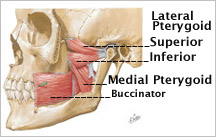This is a series on jaw pain and TMJ. If you missed the beginning, go back to Part 1.
Now that you know where the bones are and what they are called I’m going to use their anatomical names to help you find the muscles you will want to treat. If you didn’t read that part, go back to Self-Treatment: Finding the bony landmarks.
Neuromuscular Therapy Treatment protocol: When you’ve pressed hard enough to elicit a pain of 6 on a number scale of 1-10, hold the pressure for 8-12 seconds or until you feel the muscle softening or the pain lessening. If you don’t feel a change, hold for up to 20 seconds. If you still don’t feel a change, leave your fingers there and let up the pressure for several seconds then press in again. If it still doesn’t release, try a third time and go back to it later. The muscle may need time to gather the blood and nutrients it needs to let go. Also, to prevent soreness, just press. Grinding or deeply rubbing on tight muscles can irritate the tissue.
 Lateral pterygoid is the most important muscle to know for TMJ pain and one of the hardest to get to. (Lateral means toward the outside, away from the midline of the body. (Pterygoid means wing-like in Greek, indicating the shape of the muscle.)
Lateral pterygoid is the most important muscle to know for TMJ pain and one of the hardest to get to. (Lateral means toward the outside, away from the midline of the body. (Pterygoid means wing-like in Greek, indicating the shape of the muscle.)
 To treat the lateral pterygoid from the outside, find the position with your fingers under the zygomatic bone and your index finger at the TM joint by your ear. Find the soft depression with your middle finger. Open your jaw slightly and sink down into the round indentation. If your jaw is open too wide, the muscle that covers the outside of that space (deep masseter) will become taut and prevent your fingers from getting in deeper to treat the muscle you’re aiming for. If the jaw is too closed, the half-moon depression will be covered by the cheekbone. When you find the indentation, press inward (both sides, never one to prevent misaligning the joint). Above is an illustration of the indentation with the cheekbone cut away.
To treat the lateral pterygoid from the outside, find the position with your fingers under the zygomatic bone and your index finger at the TM joint by your ear. Find the soft depression with your middle finger. Open your jaw slightly and sink down into the round indentation. If your jaw is open too wide, the muscle that covers the outside of that space (deep masseter) will become taut and prevent your fingers from getting in deeper to treat the muscle you’re aiming for. If the jaw is too closed, the half-moon depression will be covered by the cheekbone. When you find the indentation, press inward (both sides, never one to prevent misaligning the joint). Above is an illustration of the indentation with the cheekbone cut away.
To treat the lateral pterygoid directly from inside the mouth (intraoral):
Slide the pad of your index finger (right jaw, right finger) along the gum of your upper teeth as far back as you can go with your mouth closed. Feel for the indentation behind the upper jaw bone (maxilla) with the tip of your finger. Press there on the inferior division of the muscle. It will probably be very uncomfortable. The superior division will probably be painful. To get to it, press upward and backward a little from the inferior indentation, then inward as much as you can tolerate. Treat one side at a time, using the treatment protocol above.
The next post will be about treating the medial pterygoid.
This is great information. Just the past 2 months I have what I presumed to be a dislocated right jaw. I have pain with complete opening of my mouth and mastication of hard food. I also have out of the blue sharp quick ear pain. It takes a few days but then my jaw goes back to normal. I wore braces 10 years ago and I know my teeth have moved since then. I am trying to get my old retainer to fit. I have a tense jaw. I did the muscle treatment for the lateral and medial pterygoid, and I plan on continuing. I had the increased pain but then the muscle seemed to relax. I am going to try to start stretching my whole body and see if with these 2 therapies my jaw trouble will decrease. Thanks for your help.
Hi Teresa,
I’m glad the information helped. I’d encourage you to go back to the dentist who fitted your appliance and have him make any necessary adjustments. If you can’t do that, you can usually buy an over-the-counter flexible night guard to keep you from clenching at night. Keep stretching and self-treating and you should improve!